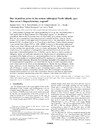Identificador persistente para citar o vincular este elemento:
https://accedacris.ulpgc.es/jspui/handle/10553/48043
| Título: | Dust deposition pulses to the eastern subtropical North Atlantic gyre: Does ocean's biogeochemistry respond? | Autores/as: | Neuer, Susanne Torres-Padrón, M. E. Gelado-Caballero, M. D. Rueda, M. J. Hernández-Brito, J. Davenport, Robert Wefer, Gerold |
Clasificación UNESCO: | 251002 Oceanografía química | Palabras clave: | Atmospheric dust deposition Particle flux Subtropical North Atlantic gyre ESTOC Iron |
Fecha de publicación: | 2004 | Editor/a: | 0886-6236 | Publicación seriada: | Global Biogeochemical Cycles | Resumen: | Enhancement of primary and export production following dust deposition pulses is well established for High Nutrient Low Chlorophyll regions, but the effect of atmospheric dust on the biogeochemistry of oligotrophic gyre regions remains unclear. Here we report atmospheric dust concentrations measured on Gran Canaria, Canary Islands, concomitantly with upper water biogeochemistry at the oligotrophic time series station ESTOC (European Station for Time series in the Ocean, Canary Islands) during a 2‐year period from winter 1997 to 1999. ESTOC is located in the eastern subtropical Atlantic gyre about 100 km north of Gran Canaria and 500 km west of the Sahara, and receives aeolian dust episodically mainly in winter and summer. We found a close correlation of the magnitude of atmospheric dust concentration in winter with the magnitude of downward particle flux at ESTOC, mainly due to a relative increase in lithogenic matter and carbonate sedimentation. Higher aerosol concentration was not accompanied by higher primary or export production, however, indicating that phytoplankton production remained unaffected by atmospheric nitrogen supply on a seasonal or yearly timescale. However, by estimating bioavailable iron input and the need of the phytoplankton population, we found that the highly episodic dust pulses might exert a feast and famine effect on the phytoplankton. Despite the high lithogenic matter input, carbonate, mainly stemming from coccolithophorids, exceeded in importance the role of lithogenic matter as ballasting agent of sinking organic matter. | URI: | https://accedacris.ulpgc.es/handle/10553/48043 | ISSN: | 0886-6236 | DOI: | 10.1029/2004GB002228 | Fuente: | Global Biogeochemical Cycles [ISSN 0886-6236], v. 18, p. 1-10 |
| Colección: | Artículos |
Citas SCOPUSTM
68
actualizado el 08-jun-2025
Citas de WEB OF SCIENCETM
Citations
64
actualizado el 08-jun-2025
Visitas
188
actualizado el 22-feb-2025
Descargas
201
actualizado el 22-feb-2025
Google ScholarTM
Verifica
Altmetric
Comparte
Exporta metadatos
Los elementos en ULPGC accedaCRIS están protegidos por derechos de autor con todos los derechos reservados, a menos que se indique lo contrario.
